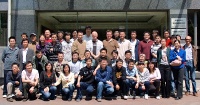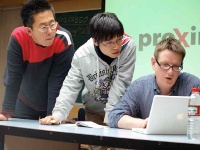 |
 |
|||||||||||||
|
|||||||||||||
|
|||||||||||||
|
“How do you ‘see’ neutrons in a scintillator calorimetry?” asks Frank Simon a group of 40 students in the afternoon three days into a five-day “Calorimetry for International Linear Collider” school, held from 22 to 26 April in Beijing. The spring in Beijing is just over outside the classroom on the CCAST campus, and the Chinese students who traveled from many academic institutions across mainland China, such as Tsinghua University, Institute of High Energy Physics Chinese Academy of Science (IHEP) and the University of Science and Technology of China (USTC), eagerly hitch forward in their seats. “Have you played billiards?” An excellent lecturer himself (and a blogger for Quantum Diaries), Simon effectively delivers his ideas as the students speak up. What target would take away momentum from neutrons? Exactly, the mass equivalent of neutrons, the protons. Hydrogen in the active medium makes the detector, and thus the plastic scintillator, sensitive to neutrons.
The school was initiated as a follow-up to last year's time projection chamber (TPC) school also held in Beijing. “The idea of calorimetry school naturally came up after the successful TPC school,” says Yuanning Gao of Tsinghua University in China, one of the two organisers of the calorimetry school. “The idea is to provide students with opportunities to learn the basics before attending international conferences which are often much harder to comprehend and require a deeper understanding.” Contacted by Gao, Roman Poeschl, a calorimetry expert at LAL (Laboratoire de l'Accélérateur Linéaire, Orsay, France), quickly organised lecturers by inviting internationally recognized calorimeter experts who work in the field. All of them agreed spontaneously to give a lecture and helped to make the school a success. “It is a wonderful opportunity to come to a country which will be of great importance for particle physics and also has many well-educated and bright minds. The idea was to present entry points to the field and the collaboration, and to form a 'platform' of linear collider calorimetry in mainland China.” The "Calorimetry for ILC" school has an extensive programme entirely focused on calorimetry: from a whole-day introduction of calorimetry to the CALICE silicon-tungsten, scintillator and digital electromagnetic calorimeter (ECal), analogue and digital hadron calorimeter (HCal), front-end electronics and the needs at CLIC energies. Finally the importance of high granular calorimeters for Particle Flow Algorithms was emphasized. “The idea was to cover very broad aspects of calorimetry,” says Poeschl. “We tried to make sure that all technologies are represented.” Liang Guan, a PhD student in physics at USTC, who took a 11-hour train journey from the city of Hefei to attend, expresses his interests in large international collaborations in high-energy physics. Lei Zhang, a PhD student at Nanjing University who is working on IHEP's BESIII, says he is very interested in linear collider experiments in the future because he has a strong interest in experiments at the high-energy frontier. He adds that every lecture was worthwhile to note even on subjects not of his specialty because they gave him a broader and deeper perspective. What comes next? “We would like to maybe go for ILC physics next year,” says Gao. The funding for such schools however is always an issue. “This school this year was paid by CCAST, NSFC and Tsinghua University. I would like travel and accommodation expenses for every student to be paid by the school.” Poeschl says he would also like to see a school on pixel detectors. In the interim the lecture series in China can be the foundation for a regular and a high-level school on ILC experimentation. Such a school would become a must once the ILC project starts moving towards its realization. -- Misato Hayashida |
|||||||||||||
| © International Linear Collider |



